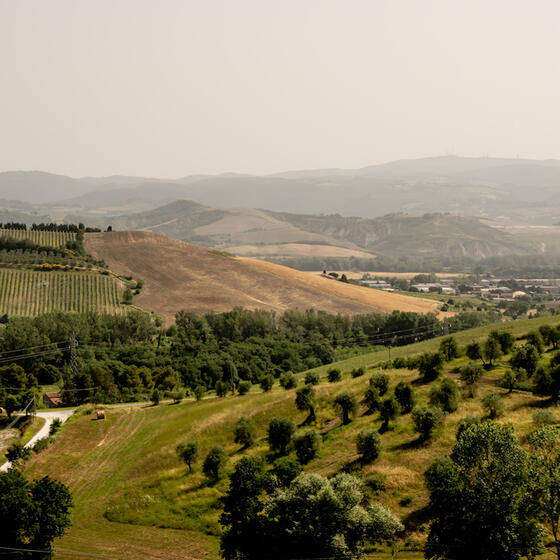In the heart of Umbria, the transformation of a fairy-tale, 1,000-year-old castle into a design-driven hotel has brought new life not just to the building but to the idyllic Italian hills that surround it
24 September, 2023
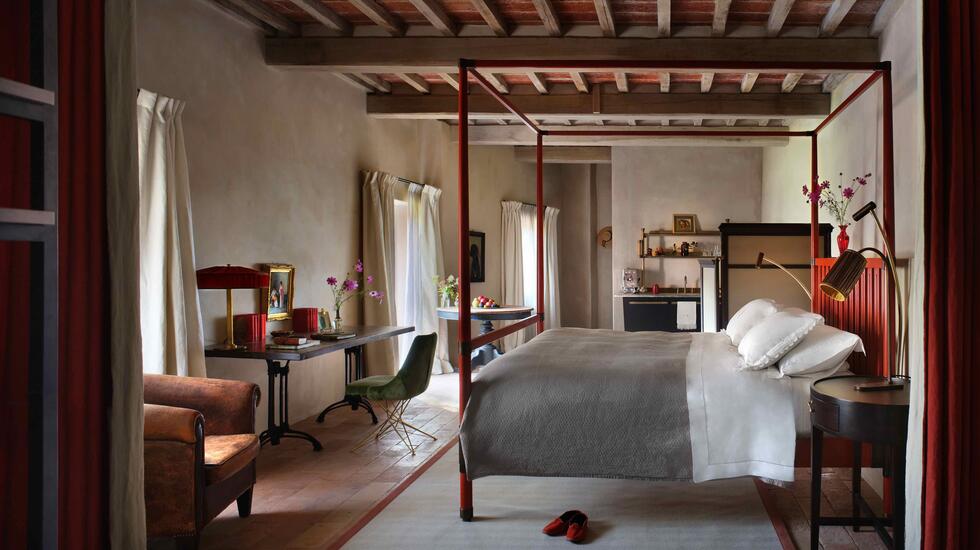
an eye out for Donna Nencia. She may turn up on a horse.”
Shielding our eyes against a lazy Umbrian sun, our small party
scans the brushy edges of a little lake. In the mustard-green
shallows, tadpoles are twitching. Two pristine rowboats nudge the
wooden pilings of the jetty. But through trees half-clad in
mid-season states of undress, there’s no sign of one of Hotel Castello di
Reschio’s purebreds, nor its rider.
It’s a uniquely Reschio kind of statement. Here, amid 1,500
glorious hectares of classic Italian countryside, it’s somehow unsurprising that a
member of the nation’s nobility might ride up to greet you. Even if
you are standing wrapped in a towel, hopping on one foot as you
attempt to remove your wet swimming costume, blotchy and fresh from
a brisk dip. This is Reschio, after all – the castle, estate and
hotel where connection with the land is just as important as the
property’s millennium-long heritage and its impeccable interior
design.
Opened to much fanfare in 2021, Hotel Castello di Reschio is the
culmination of decades of love, art and sheer hard work by one
family. Acquired by Count Antonio Bolza in 1994, the estate
comprises unspoilt oak woodland, mist-filmed lakes, vineyards,
olive groves and cypress-studied horizons, punctuated by
traditional farmhouses and cottages – some in ruins, others
immaculately restored. The estate’s centrepiece is the castle, now
home to 36 guest rooms, suites, a spa and living spaces that
reference the 1930s in breathtaking style, thanks to the creative
vision and talents of Bolza’s architect and designer son, Count
Benedikt, and his artistic wife, Donna Nencia, a princess from
Florence’s ancient Corsini family.
Rearing up from Perugia’s landscape like some medieval
spaceship, the castle dates from 1050 and was where Count Benedikt
and Donna Nencia raised their own family from the 2000s. Originally
a self-contained fortification where water and food could be stored
to enable its inhabitants to survive siege conditions, it was
always more of a defensive building than a structure for showing
off and hosting grand banquets. Its lands were productive, down the
years giving up olives, wood, wheat, fruit and – by the middle of
the 20th century – a lot of tobacco.
Today, Count Benedikt Bolza sits across a table in the
Tabaccaia, the estate’s stunningly restored 1940s tobacco factory
that serves as his BB Reschio design studio and creative hub.
Impeccably dressed, effortlessly relaxed, he gestures to a series
of aerial images, some shot by the British in the Second World
War.
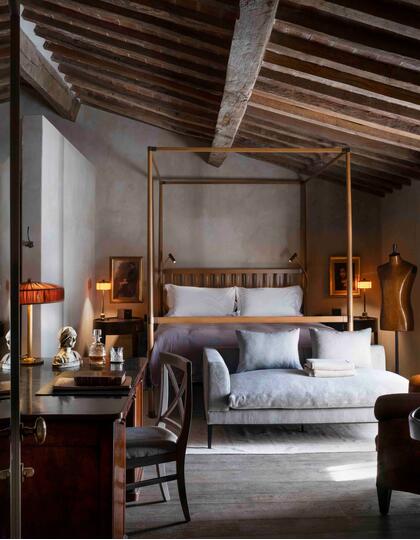
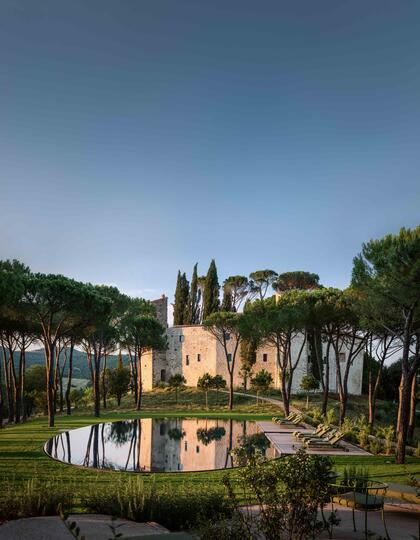
“You can see how heavily it was farmed,” he says, pointing out
the black-and-white rectangles that indicate agricultural terraces
carved into the hillsides. “Everything was done by hand; they
couldn’t work these fields with tractors. The majority of the
output was tobacco, but they were farming everything imaginable:
grain, grapevines, mulberry for silkworms that they bred in the
attics of the castle. They kept pigs in the woods. Where the
swimming pool is today there were vineyards.” He leans across the
table for emphasis. “Every inch of the estate was used. And there
were about 500 people living here, working on the land. Most of the
farmhands were children; they didn’t go to school. No electricity.
No running water. And you wouldn’t believe it but this system was
still fully active in the 1960s.”
By the time the Bolzas arrived in the 1980s – aristocratic
exiles from Communist Hungary, via Austria, who had returned to
their Italian roots – the locals had largely moved out and nature
had taken charge.
“The estate was not farmed anymore. And the houses were all
abandoned; the castle was not lived in. There were hardly any
roads. It was beautiful – very wild.”
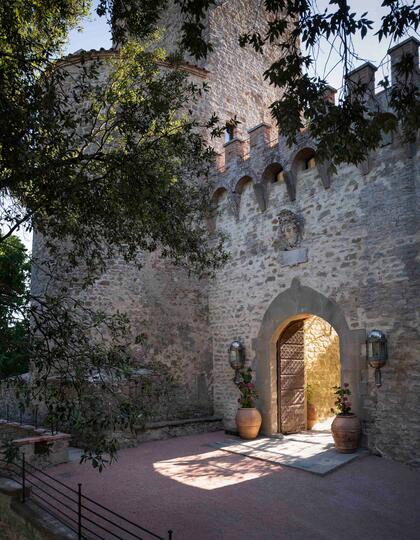
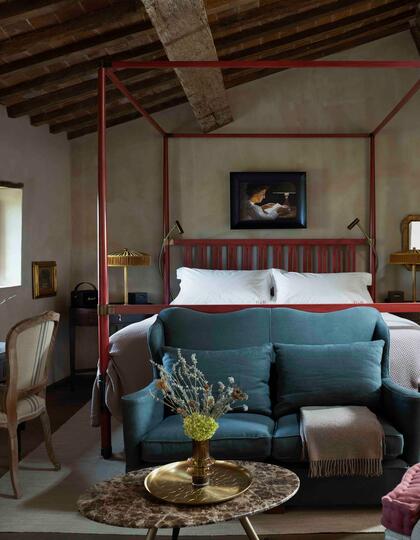
Having started with one magnificent hilltop property, San
Martino, Antonio Bolza was finally able to acquire the entire
estate in 1994, by which time Count Benedikt was studying
architecture in London. The memory of that moment still makes him
smile. “I thought this was a fabulous idea,” he says. “Because, of
course, there were 50 farmhouses, the castle and all these
incredible structures that we could restore like this” – he waves
at the interior of the Tabaccaia – “and like the stables”.
Gradually, restoration of the tumbledown properties got
underway. Electricity was brought in via underground cables.
Rainwater was channelled from Reschio’s lakes, providing a
sustainable source for the whole estate. Through the windows of the
Tabaccaia, there’s not a pylon in sight; the only apparent
infrastructure being a road snaking uphill to the fortified
building above.
“Nencia and I moved into the castle in ’99,” continues Count
Benedikt. “We had five children, all born at the time we were
there. And we loved our 11 years inside; it was a paradise. We’d
walk through this tiny door in the big gate… Just one key for the
entire house. Didn’t need to lock anything once you were inside.
And the children absolutely loved it. But it became a bit dangerous
at the end because everything was starting to fall in. So after
these 25 years of hard work, restoration, having, you know, a
wonderful community of houses here, we felt it was time to do the
castle.”
You can feel the earthly roots of Reschio’s origins in every space: an unexpected sense of home, and a connection to the land
In some ways it’s hard to imagine those early days. The
Tabaccaia alone is a masterpiece of industrial design. Downstairs,
I’d been greeted by a vintage Fiat and a roaring fire, before being
solicitously led up an open staircase and along a broad walkway
lined with examples of Count Benedikt’s signature furniture and the
light-filled offices of his architecture and design team. There are
curvaceous, brass-wrapped side tables, bar stools with
buttoned-leather finishes, steel and velvet standard lamps – all
designed by Count Benedikt, made by local artisans and available
for guests to purchase. As with the luxuriously appointed guest
rooms – which are softly lit and strong on organic textures and
natural, if gleaming, finishes – everything feels sinuous and
timeless.
Yet you can feel the earthly roots of Reschio’s origins in every
space: an unexpected sense of home, and a connection to the land.
Stepping through the great gated entrance to the castle proper,
you’re greeted not by the standard reception area but rather by the
Boot Room, facing onto the inner courtyard lined with guest rooms.
No dreary welcome drinks and forced chat here – instead, a long
beamed space with a great crackling fire, shelves lined with glass
vases and huge sprays of wildflowers from the estate, waiting to be
arranged into artforms by Donna Nencia at the rustic wooden
table.
Here, too, is the Palm Court – a soaring glasshouse with a
reclaimed herringbone brick floor, elegant tropical trees, playful
palm lamps, high-backed bamboo chairs and velvet sofas, cunningly
laid out so as to give each lounge setting a sense of privacy.
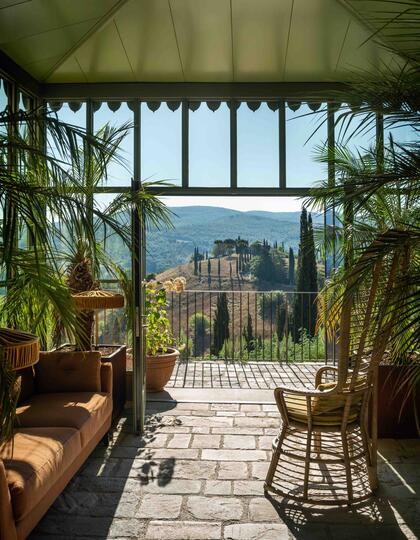
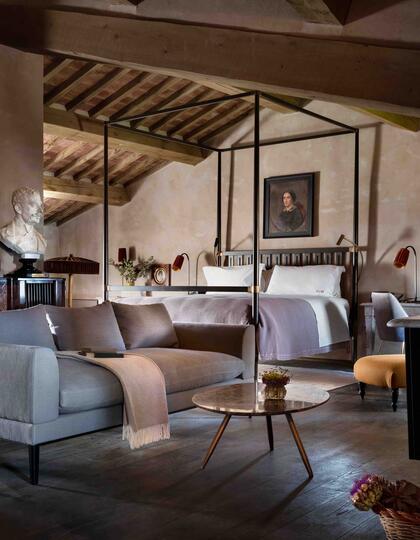
Below your feet, the Bathhouse occupies the castle’s former
white wine cellars, and it’s here more than anywhere that you’re
most likely to feel the property’s medieval heritage, as you’re
massaged and dry-brushed in a huge stone room, lit by candles and
yet another enormous blazing fire. Next door, stone steps lead you
down into the Roman Bath, where you can wallow privately in warm
saltwater and watch shafts of sunlight spearing the chamber.
Fire and water are running themes throughout Reschio. “I love
fireplaces and I put them everywhere,” says Count Benedikt, who
designed the fire grates throughout. “They’re so easy because
nothing can fall out and they don’t smoke. It’s amazing how many
guests nowadays are not used to fire any more, but I notice that
when people come to the hotel, they always go straight to it.
There’s a real connection going on.”
Two-thirds of the estate is woodland, the majority of it oak,
which has remained uncut for the past 30 years, and is no longer
harvested for firewood. “We don’t need to plant because it’s so
vigorous,” says Count Benedikt. “Rather, what we’re doing is
helping the undergrowth to stay clear so we could develop a
high-canopy woodland – called alto fusto in Italian – and highly
protected by the state.”
What land they do cultivate is these days turned over to a range
of biodynamically grown crops suited to the terroir: olives and
grapevines, of course – this is sangiovese territory – but also
ancient grains, chickpeas and hemp. In what Count Benedikt
describes as a “closed circle” approach, the estate is designed to
be as self-sufficient as possible.
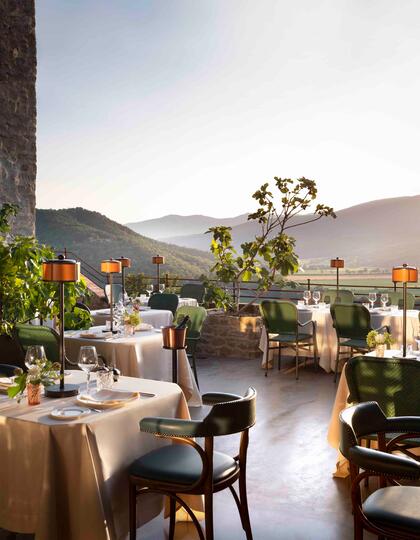
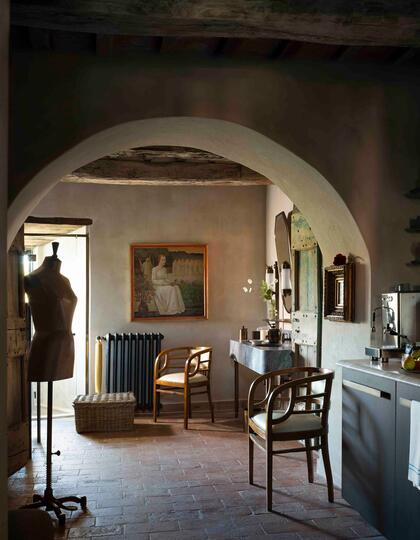
The same philosophy applies to the ongoing restoration work of
the old estate houses, some of which have been bought by private
owners, but 10 of which are available to rent year-round. All the
building material comes from the existing sites of the buildings,
which date from 800 years old up to the pre-war period: sturdy old
roof tiles, beams and sometimes steel girders.
Produce for the hotel’s restaurants all comes from the estate or
its immediate surroundings: Reschio supplies its farmers with
high-quality seeds, which are then planted and resupplied back to
the estate as fruit and veg. There’s Reschio-grown wine, gin, amaro
and an outstanding olive oil. Tumbling down the hill outside the
castle ramparts are naturally growing wild herbs and medicinal
plants that Reschio resident and botanist Selvatica Cipriani guides
us through, stopping every few steps to help us select sprigs to
make our own herbal tea: “Choose whatever calls out to you! Your
body knows and will thank you.”
My body is certainly grateful the morning we’re driven out to
the lake and told that Donna Nencia may be dropping by to say
hello. Having kicked through the icy water for 20 minutes until my
hands ached with cold, we’re now draped over campaign chairs on the
deck of the lakehouse, sipping freshly pulled cappuccinos and
inhaling pastries and the crisp morning air. Reschio is home to a
dressage arena and a stable full of Spanish purebreds that are the
pride of Antonio Bolza, who still lives on the estate and rides
every day, and we’re hoping to catch a glimpse of our hostess
riding one.
As we wait, I think of something Count Benedikt said: “What I
think is interesting is how the slowness – slow food, slow
evolution, slow development – has really helped Reschio evolve in
the correct way. Of course, most businesses would go bust if they
had to wait to evolve so slowly, but for us it was the only option.
In a way, it was our saviour.”
Suites cost from £758 per night (minimum two-night stay),
including breakfast for two. The hotel closes for the season on 3
January and reopens 16 March 2024, but individual houses are still
available to rent during this time. For further information and
bookings, visit reschio.com
